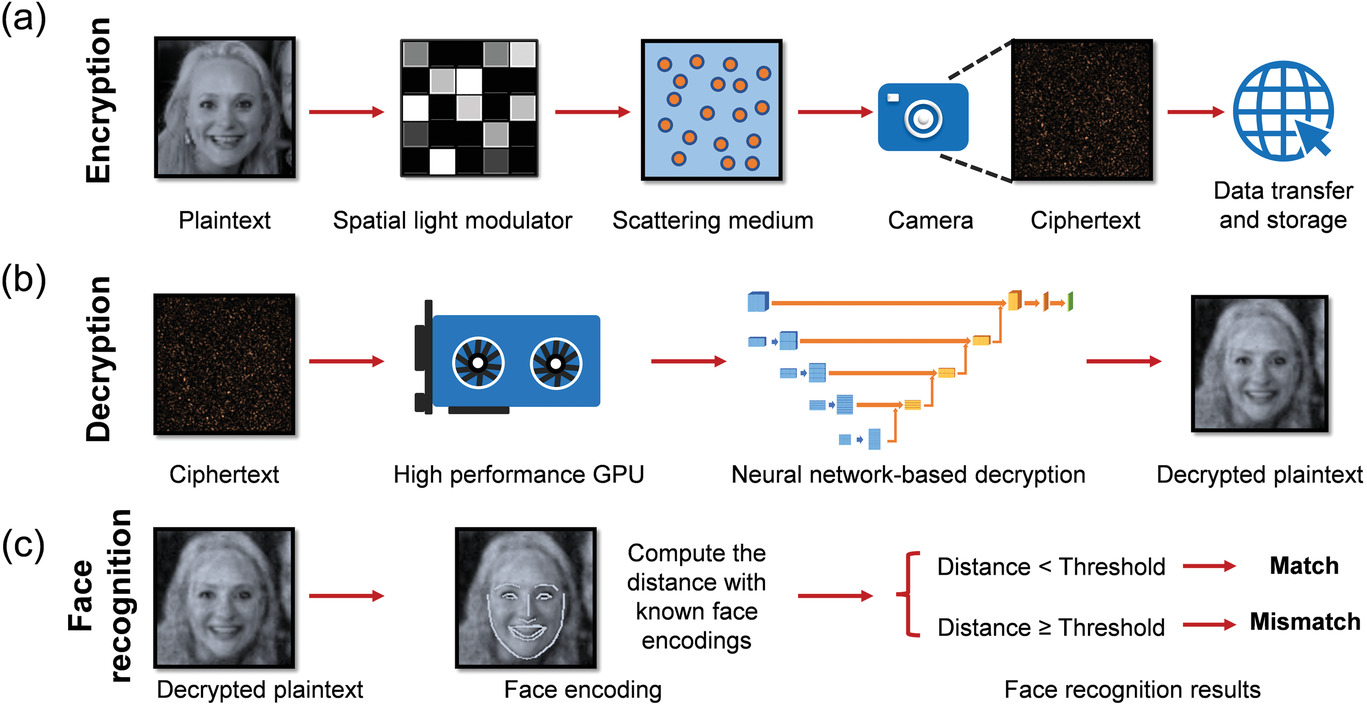Speckle-Based Optical Cryptosystem and its Application for Human Face Recognition via Deep Learning
Author: Qi Zhao†, Huanhao Li†, Zhipeng Yu†, Chi Man Woo, Tianting Zhong, Shengfu Cheng, Yuanjin Zheng, Honglin Liu, Jie Tian*, Puxiang Lai*
Corresponding author: Jie Tian* (School of Medical Science and Engineering, Beihang University) tian@ieee.org
Corresponding author: Puxiang Lai* (Department of Biomedical Engineering, Hong Kong Polytechnic University) puxiang.lai@polyu.edu.hk
Abstract: Face recognition has become ubiquitous for authentication or security purposes. Meanwhile, there are increasing concerns about the privacy of face images, which are sensitive biometric data and should be protected. Software-based cryptosystems are widely adopted to encrypt face images, but the security level is limited by insufficient digital secret key length or computing power. Hardware-based optical cryptosystems can generate enormously longer secret keys and enable encryption at light speed, but most reported optical methods, such as double random phase encryption, are less compatible with other systems due to system complexity. In this study, a plain yet highly efficient speckle-based optical cryptosystem is proposed and implemented. A scattering ground glass is exploited to generate physical secret keys of 17.2 gigabit length and encrypt face images via seemingly random optical speckles at light speed. Face images can then be decrypted from random speckles by a well-trained decryption neural network, such that face recognition can be realized with up to 98% accuracy. Furthermore, attack analyses are carried out to show the cryptosystem’s security. Due to its high security, fast speed, and low cost, the speckle-based optical cryptosystem is suitable for practical applications and can inspire other high-security cryptosystems.

The flowchart of the proposed cryptosystem for face recognition. a) Speckle encryption: face images (plaintext) are loaded on a spatial light modulator (SLM) to generate the corresponding speckles (ciphertext) when coherent light reflected by the SLM transmits through a scattering medium, which serves as the unique physical secret key. The ciphertext is safely transferred and stored via the cloud. No face images need to be kept in the database after encryption. b) Learning-based decryption: a neural network is trained in advance to link the plaintext with the ciphertext. After training, new random speckle patterns (ciphertext) are directly fed into the neural network for decryption, and the decrypted face images are then utilized for face recognition. c) Face recognition: the camera-recorded face images are encoded to unique 128-dimensional vectors of each known face image. After decryption, the face encoding distances between the decrypted images and the known face encodings are computed: if the encoding distance is less than a pre-set threshold, the face recognition result is “Match” (the same person), otherwise it is “Mismatch” (different people). Plaintext image: Reproduced under terms of the CC-BY 2.0 license. Copyright 2015, Lawrence Lessig at Second Home London, by Innotech Summit, Flickr (https://www.flickr.com/photos/115363358@N03/18260388752/). The original image is cropped and converted to gray-scale.
Related papers
Statistically stationary random light for high-security encryption
Shuqin Lin, Xinlei Zhu, Yijie Shen, Fei Wang, Xianfeng Chen, Greg Gbur, Yangjian Cai, and Jiayi Yu*
08/25 Optica DOI: 10.1364/OPTICA.546899
Light in, sound keys out: photoacoustic PUFs from stochastic nanocomposites
Taehyun Park, Junhyung Kim, Raksan Ko, Byullee Park*, Hocheon Yoo*
08/2025 Nature Communications DOI: 10.1038/s41467-025-62747-1
Optical encryption via four operations of orbital angular momentum
Yangsheng Yuan, Zihan Cong, Yaru Gao, Jianghao Li, Yuefeng Zhao, Bernhard J. Hoenders, Yangjian Cai*, Hui Zhang*
07/2025 APL Photonics DOI: 10.1063/5.0250395
A cryptosystem for face recognition based on optical interference and phase truncation theory
Yuan Guo*, Ping Zhai, Debao Jia, Wenpeng Li
07/2025 Scientific Reports DOI: 10.1038/s41598-025-06990-y
High-security optical encryption based on single-pixel imaging and structured light multiplexing holography
Sheng Wang, Zhenyu Zhang, Shangyin Zhou, Bijun Xu, and Xiaogang Wang*
03/2025 Optics Letters DOI: 10.1364/OL.557688
Large-scale scattering-augmented optical encryption
Liheng Bian*, Xuyang Chang, Shaowei Jiang, Liming Yang, Xinrui Zhan, Shicong Liu, Daoyu Li, Rong Yan, Zhen Gao & Jun Zhang*
11/2024 Nature Communications 10.1038/s41467-024-54168-3
Speckle visual cryptography for credential authentication
Anqing Jiao, Yupeng Zhu, Zhaoke Mi, Xinlong Zhou, Qiaofen Zhu, Changjun Ke, and Yishi Shi*
05/2024 Applied Optics 10.1364/AO.522918